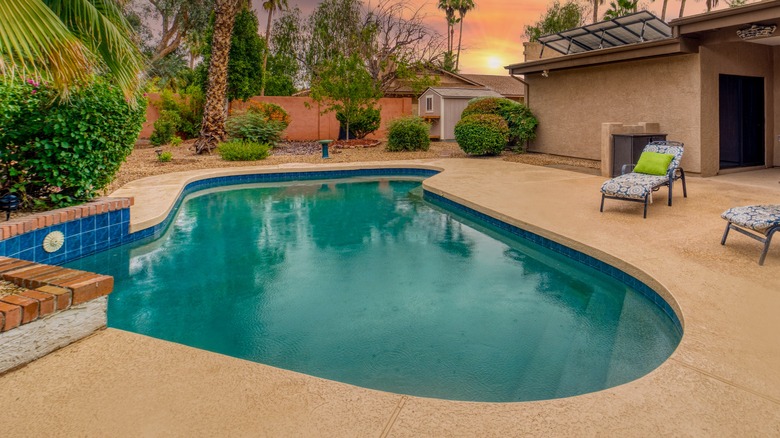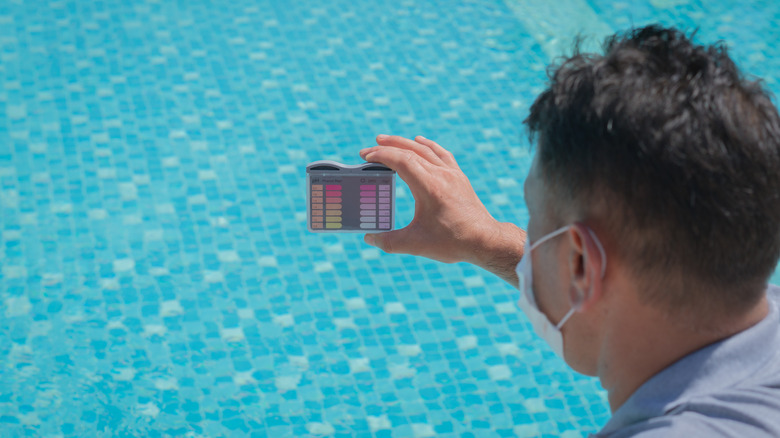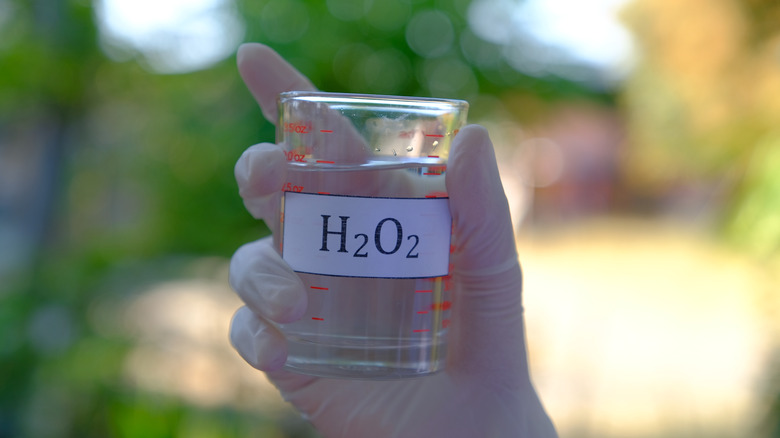Why You Should Pour Hydrogen Peroxide Into Your Pool
We may receive a commission on purchases made from links.
Pools can be such a wonderful escape, but often the effects of chlorine on our eyes, skin, and hair are enough to keep us away. Sometimes, just walking into the vicinity of a hotel or gym's indoor pool can irritate our lungs with the harsh chemical fumes. If you love the idea of a pool but hate the thought of constant exposure to chlorine, a "natural" swimming pool that uses hydrogen peroxide instead of chlorine might be just what you need. Hydrogen peroxide is essentially water with an extra oxygen molecule, and while it doesn't disinfect pool water — you'll need a UV disinfecting agent to work in combination with the hydrogen peroxide – it oxidizes at a level that is 30% more powerful than chlorine, with none of the harmful side effects.
Hydrogen peroxide, when used in a pool, breaks down when exposed to light and heat into nothing but water and oxygen, leaving no harmful chemicals behind. At these concentrations, it's not only safe to swim in but safe to drain around your landscaping. Chlorine, on the other hand, has been known to increase incidents of asthma and eye irritation, per Health. For these reasons, you might consider hydrogen peroxide as the better option.
Converting your pool from chlorine to hydrogen peroxide
If you already have a chlorinated pool, you can easily change it over to hydrogen peroxide, but you will need to implement 24-hour ultraviolet purification first to react with the hydrogen peroxide and create a suitable disinfectant. There are specialty retailers who can set these up, or confident DIYers can pick one up on Amazon or pool supply stores. Just be sure to purchase one that will accommodate the size of your pool, pump, and filter with an appropriate flow rate. They are fairly easy to install and will kill nearly all the harmful bacteria and other microorganisms that could be lurking in your pool water. Combined with the hydrogen peroxide treatment, your pool will be sparkling clean and irritant-free.
You don't have to wait for your chlorine levels to drop before starting your conversion process, but since you shouldn't use hydrogen peroxide in conjunction with chlorine at high concentrations, it wouldn't hurt. To begin, simply shock your pool water with hydrogen peroxide by adding a food grade 35% solution (not the 3% solution sold in the plain brown bottle at pharmacies) at a ratio of 1 cup for every 250 gallons of pool water, then letting your pump run for at least six hours before swimming. Follow that up with weekly tests of the water's composition, adding 1 cup of hydrogen peroxide for every 500 gallons of pool water any time the concentration dips below 50 parts per million.
Precautions and warnings
Hydrogen peroxide can be highly volatile in its pure form. It's even a hazardous material when shipped. While safe to swim in once it's diluted in your pool, it's important to wear safety goggles and protective gloves when handling the concentrated solution. In addition, hydrogen peroxide breaks down quickly when exposed to light and heat, so it must be stored in a cool, dark place – an uninsulated outdoor shed in the summertime won't suffice, but a small refrigerator in that shed might. You should also keep it out of reach of children, keep it away from high concentrations of ammonia, bleach, and vinegar, and only use it in well-ventilated areas. It should be said that while the hydrogen peroxide solution is "food grade," you should not, under any circumstances, ingest it.
Furthermore, while your pool concentration of hydrogen peroxide should be kept between 50-90 parts per million, don't let it rise above 100 parts per million. At this concentration, hydrogen peroxide can start to cause damage to the eyes and other irritations. This might seem like too small a window, but even in a 6x6 foot swimming pool that's only 4 feet deep, there are over 1000 gallons of water, meaning that you might have more wiggle room than you think. By checking your water regularly and ensuring you only add hydrogen peroxide when the concentration dips below 50 parts per million, you should remain in the safe zone without worry.


